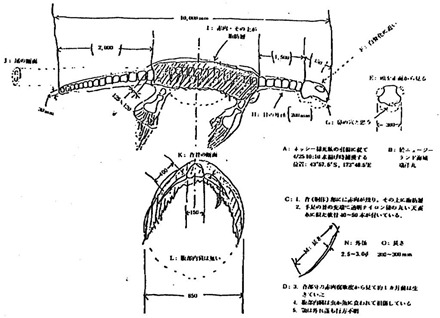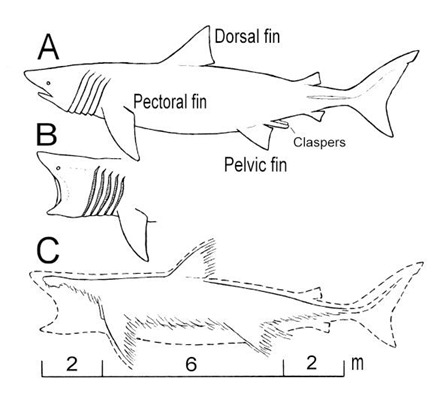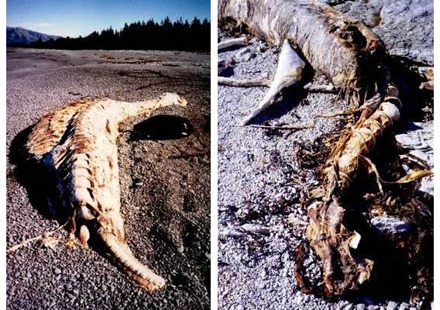The Story
In 1977, a Japanese fishing boat named the Zuiyo Maru hauled in a creature measuring around 33 feet long and weighing about 4,000 pounds off the coast of New Zealand. The creature had gotten caught in the boat’s fishing net about 1,000 feet underwater.
Crewmembers initially thought the creature to be either a rotten whale or a giant turtle missing its shell. Upon closer inspection, though, the creature appeared to have an elongated neck, small head, and symmetrical front and rear flippers similar to descriptions of the infamous Loch Ness Monster.
Five photographs were taken by the Zuiyo Maru’s Michihiko Yano; three of the creature hoisted in the air, and two of the creature after it had slipped out of the netting and onto the ship’s deck. Fearing that the rotten smell and slimy consistency of the carcass would spoil the fish that the boat had hauled in earlier, the decision was made to throw the creature back into the water.
Before that, though, Yano had the foresight to measure the carcass and cut some 42 pieces of fibrous material from one of the fins. He later sketched the following drawing:
Once back in Japan, Yano went before a panel of scientists that had been convened to study the creature. According to a 1977 article in Oceans Magazine, Yano explained the following:
“It was caught in a trawl net. The surface of the body was loose and had white fat. I could see flesh here and there, but it was dark red and was rotten. There were no internal organs. Judging from the condition of the red meat, we think it was alive until a month ago. The fat was pulling away in threads like tofu (soybean curd) and the deck turned white. It smelled terrible. The smell was not that of fish, but of an animal. At first I thought it was a whale. I reported, ‘It’s a rotten whale. What shall we do?’ The captain (Akira Tanaka) ordered ‘Pull it up as it is.’ We wanted to release it in the sea outside the net basin … It’s common practice not to pick up the rotten dead body of a creature because the ships deal with food for human beings … The crewmen knew that if we picked it up, we’d have to clean and sanitize the decks. But we got it untangled from the net and pulled it out with ropes around the middle of the body. The rope wasn’t well handled and it fell suddenly. So we lifted the neck and I took the pictures.”
[youtube=http://www.youtube.com/watch?v=udD8hGuGUeQ&hl=en_US&fs=1&]
Possible Explanations
Several early theories abounded concerning the creature. Amongst the panel of scientists, it was offered that the carcass may have been that of a shark, a whale, a turtle, or some sort of long-lost prehistoric reptile.
“If it’s a reptile, it looks like a plesiosaur,” said one of the scientists. “The Plesiosauri had fins in the front and back, and the neck and tail weren’t too terribly long.” Others discounted the plesiosaur theory altogether. “When an animal dies and rots, it looks like something else, even though we’re used to seeing the creature when it’s alive,” said one scientist.
The Shark Theory
Several scientists believed that the Zuiyo Maru had simply pulled up the body of a basking shark. According to the Oceans Magazine article, Dr. Bobby Schaeffer, curator of vertebrate paleontology at the American Museum of Natural History in New York City said,
“It’s baloney. Every ten years or so, something is found, usually in the Pacific, and people think it’s a dinosaur. And it always turns out to be a basking shark, or an adolescent whale. When sharks find a dead whale, they have a merry old time, and the half-eaten corpse looks like a dinosaur skeleton.”
Dr. Alwyne Wheeler of London’s Natural History Museum echoed Schaeffer’s sentiments in a 1977 New Scientist article.
“Sharks are cartilaginous fish. When they start to decompose after death, the head and gills are first to drop from the body … Greater experts than the Japanese fishermen have been foiled by the similarity of shark remains to a plesiosaur.”
A diagram in a 1997 article from Reports of the National Center for Science Education depicts similarities between the decayed remains of a basking shark and whatever was pulled up onto the Zuiyo Maru:
The Science
The fibrous tissue that Yano pulled from one of the creature’s fins was tested and, according to the Reports of the National Center for Science Education article, the tissue contained elastoidin, “a collagenous protein known only from sharks and rays (not reptiles or even other fish).” Furthermore, the levels of several amino acids found in the sample either matched or were found to be very close to the levels in a sample from a known basking shark.
While some still question the scientific evidence, it appears that the shark theory holds up for plenty of researchers, scientists, and academics. That hasn’t stopped weird looking carcasses from washing up on shore in New Zealand. Two strange looking animals were found on the same stretch of New Zealand’s Kaikoura Peninsula within three months of each other; one in December of 1998 and the other in January of 1999.
And while “the first reaction from mainstream scholars was that the photographs showed nothing more than two massively decomposed carcasses of what were once basking sharks,” according to AmericanMonsters.com, you’d be forgiven for wondering what in the world you were looking at if you happened to come across one of them.
Further Reading
New Nessie (Wikipedia)
What Was the New Zealand Monster? (Oceans Magazine)
Sea-monster or Shark? An Analysis of a Supposed Plesiosaur Carcass Netted in 1977 (Reports of the National Center for Science Education)
New Zuiyo Maru Cryptid Observations–Strong Indications It Was a Marine Tetrapod (Creation Research Society Quarterly Journal)
Plesiosaur (Wikipedia)
Basking shark (Wikipedia)
ZUIYO-MARU CARCASS (American Monsters)
KAIKOURA CARCASSES (American Monsters)




